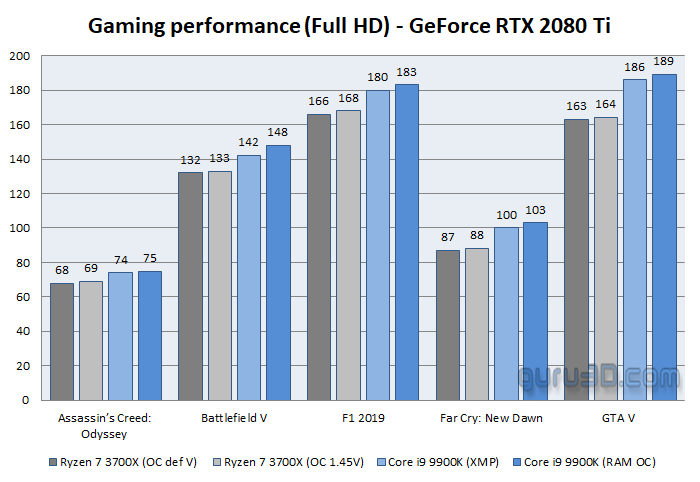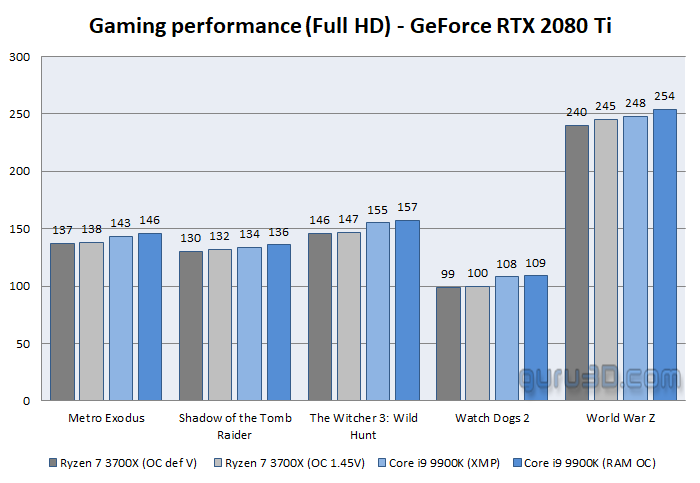Final Words & Conclusion
Final Words & conclusion
The G.Skill TridentZ Royal kit that we’ve tested here is a great set. Four 8 GB modules with a default frequency of 4000 MHz with great timings (17-17-17-37) leave nothing to be desired and can still be tuned further. If you look at the current situation, it’s clear that this kit is mainly intended for Intel-based systems because if you want to have top performance in an AMD system, you need to stick to 3600-3733 MHz in order to keep the Infinity Fabric divider at 1:1 (to avoid suffering any score decrease at 2:1). The heat spreader comes in gold and silver, and we got the former. The range of available frequencies is comprehensive. The slowest module in this series operates at 2660 MHz, and the fastest one reaches an astounding 4800 MHz, so everyone should find their match.
Aesthetics
G.Skill has managed to make the TridentZ Royal just wonderful. You can opt for a Silver- or Gold-themed heat spreader - it's shiny and reflective but looks fantastic. The 8-zone RGB LED system with crystalized top design produces a great result.
Tweaking
The memory chips used here come from Samsung, and they’re B-die chips (with 10-layers PCB). We achieved a nice CL14 at 3600 Mhz and 1.45 V (1.35 V is the baseline value which allowed slightly less restrictive timings) on AMD and CL18 at 4400 Mhz and 1.45 V (1.35 V default) on Intel. You can always try to lower the latencies and go even higher with the frequency.
Gaming performance
That's a 1920x1080 (Full HD) gaming chart based on the GeForce RTX 2080 Ti. You can see the differences between the 8 core CPUs from AMD and Intel and what improvement you can achieve after overclocking each system's memory. Is it worth it? It's your call (but you need to remember the OC is free and only need some time to set/test the stability).
Conclusion
G.Skill Trident Z Royal provides a default frequency (4000 MHz) that will be enough for virtually any users, and the XMP 2.0 profile makes life easier. If you want more, you can try to overclock the memory even further. With the reviewed kit, on our X470 and Z390 platforms, it was possible to achieve 4400 MHz with CL18 with the Intel system, whereas with the AMD one, we stayed at 3600 Mhz to have the Infinity Fabric divider set at 1:1, but with optimized timings. It’s a great result, but we did expect that, as the kit is one of the best out there. You could achieve even more with Z490 systems, though, but we don’t have that on our test bench (yet). You need to remember that reproducibility is never guaranteed, and your results may vary. The heat spreader is a relatively low-profile one (44 mm), so you shouldn’t encounter clearance problems with most CPU coolers. The 32 GB capacity is a lot for most users nowadays, but it’s becoming more common due to dropping RAM prices. The 4 x 8GB is priced at just over 400 USD, which is a lot, but you need to remember that this is absolutely high end. The overclock that we achieved was very nice. Ryzen fans should be more satisfied, especially ones loving to dig deeper into the timings (because 4000 MHz is not supported with IF set to 1:1). On the other hand, Intel lovers have more headroom for tweaks; in this case, it was possible to gain 400 MHz (10% increase). We can easily give G.Skill a “Guru3D recommended” award for this great and blazing-fast kit. The price is the only aspect that many users may find difficult to accept. Still, this is not a product for the masses, but rather for enthusiasts. Royal performance commands a royal price.
- Sign up to receive a notification when we publish a new article
- Or go back to Guru3D's front page.




